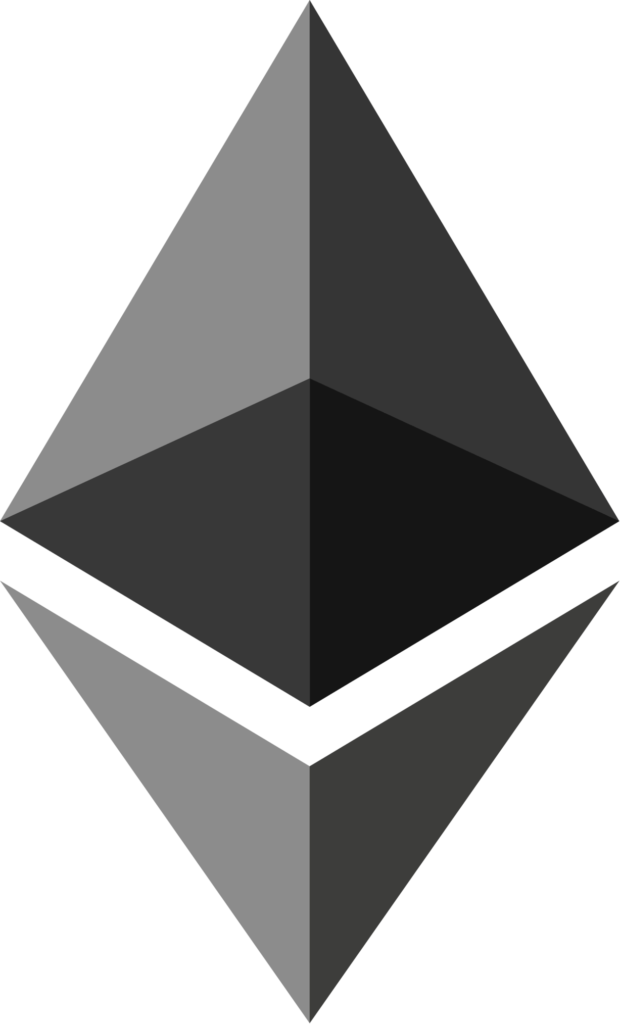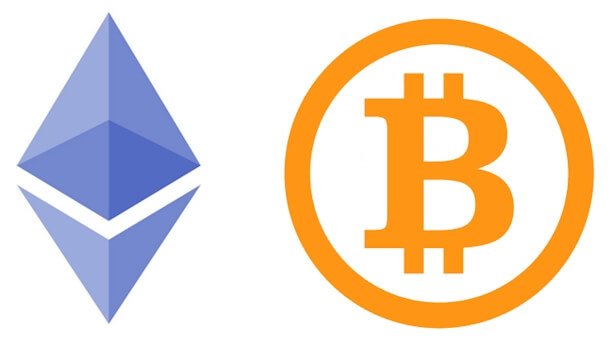The original Ethereum logo was designed shortly before Ethereum was launched. Prior to that, there had neither been tentative ideas nor preliminary preparation. One of Ethereum’s founders simply drew the logo using the Texture application.
The original Ethereum logo was made up of a pair of ∑ characters spun 45 degrees on either side. Therefore, the figure resembled a diamond and was used in the early phase of the product’s development and was only unveiled during the implementation phase. A special competition was then held, from which the owners picked the modernized variant of the original logo.
Ethereum’s visual identity is a diamond-shaped figure that comprises six triangles—four triangles above two triangles at the bottom. Thanks to the combination of colors that create the shadows and the strict design, the symbol looks 3-dimensional and resembles a pyramid with different faces and four edges.
There’s an empty space between the top four and the bottom two triangles that make up the Ethereum logo. There’s no official explanation for that, but it’s believed that the emblem is a polyhedron—symbolizing many possibilities, even when they don’t seem to be there.
The Ethereum Logo Design Elements

Font: The Ethereum wordmark logo is rendered in Roboto sans-serif font, which Google created for the Android application. While the wordmark looks like classic symbology, it’s not used widely and is only used for applications.
Color: Ethereum logo has a number of other logos designed specifically for regional services. They are drawn in different colors, depending on the color of a country’s flag. However, there are also alternate versions portraying general cultural ties.
Even so, the basic colors of the Ethereum logo are black, white, and gray with varying levels of transparency. The darkest triangle is the central right, while the central left one is lighter and looks dark grey.
Two more triangles are light gray. Due to this combination of shades, a visual image of a pair of cones with one common white platform emerges, with one of them inverted (upside down).
The Ethereum wordmark was written in dark gray. In addition, the “Powered by Ethereum” wordmark is written in gold.
The History of Ethereum

While Ethereum was founded by a number of people, the first person to explain the idea behind Ethereum was Vitalik Buterin in November 2013. After Buterin’s initial groundwork, other brains came on board in different capacities to help make the vision a reality.
As such, those who co-founded Ethereum include Vitalik Buterin, Jeffrey Wilcke, Antonio Di Iorio, Amir Chetrit, Joseph Lubin, Mihai Alisie, Gavin Wood and Charles Hoskinson.
In early 2014, Ethereum started becoming popular when Buterin introduced the idea behind the blockchain project to the public at a Bitcoin convention in Miami, Florida. Later the same year, the project received funding through an initial coin offering, selling ETH coins worth millions of dollars. ETH coins worth $18 million were sold, bought through Bitcoin.
While it was possible to buy ETH coins in 2014, Ethereum didn’t actually go live before the 30th of July 2015. This means that ETH buyers were forced to wait until the Ethereum blockchain was launched in order to use or move their ETH.
What is Ethereum?

Ethereum is just one of the thousands of cryptocurrencies available today. Ethereum is the brainchild of eight people and was founded in 2015. While the platform or cryptocurrency is known as Ethereum, the individual unit is known as an Ether.
Ethereum runs on a distributed ledger or decentralized computer network known as a blockchain, which tracks and manages the currency. In other words, a blockchain is like a continuous receipt of each and every transaction that has ever been done in the cryptocurrency. Each computer in the network will verify the transactions and maintain the data’s integrity.
This decentralized computer network is one of the reasons why people love cryptocurrencies like Ethereum. Users can also send and receive money without having to use a central intermediary like a bank, so the absence of an intermediary means that Ethereum is almost autonomous. Moreover, Ethereum lets users make transactions virtually anonymously, even when the transaction is available to everyone on the blockchain.
While the entire cryptocurrency field is described in currency terms, it may be better to consider cryptocurrency as a token you can spend for a particular purpose facilitated by Ethereum. For instance, buying and selling items or sending money is facilitated by Ethereum. But Ethereum does much more than that because it can also facilitate smart contracts as well as other apps.
How Ethereum Works
Like every cryptocurrency, Ethereum runs on a blockchain network, which is a network of distributed or decentralized ledger where every transaction is verified and recorded.
A blockchain network is a distributed ledger because everyone using the Ethereum network has the same copy of the ledger, letting them view all previous transactions. Then again, a blockchain network is decentralized because the network is not managed or run by any centralized party—instead, it is run by everyone with a distributed ledger.
Blockchain transactions employ cryptography to secure the network and verify transactions. Users use computers to solve complex math equations (aka to “mine”) that confirm all transactions on the network as well as add fresh blocks to the network that’s central to the system. Ethereum users are gifted cryptocurrency tokens in the form of Ether (ETH).
Like Bitcoin, Either may be used to sell and buy goods and services. Its price has also soared in recent times, making it a good speculative investment. But Ethereum is quite unique because users can develop applications that work through it just like software runs on computers. These applications can carry out complex financial transactions or transfer and store personal data.
Ethereum’s Ongoing Evolution
Ethereum’s founders were some of the first people to consider the possibility of using blockchain technology for more than just securing the trading of digital currency. Its cryptocurrency unit ETH was primarily created as a means of payment for applications created on the platform.
Ethereum’s invulnerability to online snoopers and hackers has created the potential for storing private information from voting systems to healthcare records. Its dependence on cryptocurrency gave programmers possibilities to develop and market business applications and games on the network.
Ethereum 2.0
By May 2021, Ethereum was the second-biggest virtual currency in the world, behind only Bitcoin. In 2018, the number of Ethers in circulation was more than 100 million.
Unlike Bitcoin, the number of Ethers that may be created is unlimited.
Ethereum is currently going through a long-overdue upgrade called Ethereum 2.0, which aims to enable the network to scale up while sorting out congestion issues that have in the past slowed it down. In fact, a game known as CrypoKitties single-handedly held up transactions on the network in 2017.
Ethereum’s ambitions are wider than those of Bitcoin. It aims to host all types of apps that can safely store information.
The Hard Fork
While a blockchain can be immune to hacker attacks, this doesn’t mean that hackers haven’t tried their luck. In 2016, a spiteful actor stole over $50 million worth of Ether that was meant for a project known as The DAO, a bunch of smart contracts developed by someone else. A third-party developer was blamed for the successful raid.
The Ethereum Community chose to undo the theft by coming up with a “hard fork,” canceling the existing Ethereum blockchain and creating another one. The original is called Ethereum Classic.
Ethereum vs. Bitcoin

While Ethereum and Bitcoin share many similarities, there are also notable differences between them, including:
- Ethereum trades in several ways, including the Ethereum Virtual Machine, smart contracts, and cryptocurrency, while Bitcoin only trades in cryptocurrency.
- Ethereum uses different security protocols to Bitcoin. While Bitcoin uses the “proof of work” system, Ethereum uses the “proof of stake” method.
- While Ethereum allows both unauthorized and authorized transactions to go through, Bitcoin only allows public (unauthorized or censor-proof) transactions.
- In general, Ethereum has a significantly less block time than Bitcoin—12 seconds instead of 10 minutes. This means more block confirmations, allowing Ethereum users to confirm more blocks and get more Ether.
- By 2021, it was estimated that only 50% of Ether coins will have been mined (over 90 million tokens). In contrast, most Bitcoins have already been mined (there are just 21 million tokens in circulation).
- The miners (computers) running the Bitcoin platform and verifying transactions get rewards. Essentially, the first computer to solve every new block receives a fraction of one Bitcoin or Bitcoins as a reward. On the other hand, Ethereum offers no block rewards but rather lets miners receive a transaction fee.
Ethereum Pros and Cons
The Pros:
Large, existing network. Ethereum has a huge and devoted global community as well as the biggest ecosystem in cryptocurrency and blockchain.
No intermediaries. The decentralized network of Ethereum allows users to avoid intermediaries, such as banks that facilitate financial transactions, lawyers who draft and interpret contracts, or third-party web hosts.
Constant innovation: A huge community of developers is continuously looking for fresh ways to improve Ethereum and create new applications. Due to the popularity of Ethereum, it’s often the blockchain network of choice for existing, new, and at times risky decentralized applications.
Wide variety of functions: Apart from acting as a virtual currency, Ethereum may also help to process other kinds of financial transactions, store information for third-party applications, and execute smart contracts.
The Cons:
Developers have a steep learning curve. Ethereum can be hard for developers to learn as they leave centralized processing for decentralized networks.
Possibility of crypto inflation: Although Ethereum releases a maximum of 18 million Ethers every year, there’s no limit on the number of Ethereum coins that can be released. This might mean that investing in Ethereum is more like investing in dollars, and it might not appreciate as readily as Bitcoin, which comes with a lifetime limit on how many coins can be released.
Increasing transaction costs. Ethereum’s rising popularity has resulted in increased transaction costs. Also called “gas,” Ethereum transaction fees reached an all-time high of $23 per transaction in early 2021, which is good news for those earning money as miners and not so great for those trying to access the network. Unlike Bitcoin, which rewards transaction verifiers, those taking part in an Ethereum transaction are required to pay the fee.
Uncertain future. Ethereum keeps improving and evolving, and the continuing development of Ethereum version 2 holds the promise of greater efficiency and new functions. However, this major upgrade on the network is causing uncertainty for applications and deals currently being used.
The Future of Ethereum
Ethereum is a major stakeholder in the cryptocurrency industry, as proven by the wide range of solutions developed on the blockchain and its second-highest market capitalization.
However, the network has had troubles with scaling up. Its transition to Ethereum 2.0 aims to sort out these problems. The transition will take some time to work, so only time will tell whether the results are good or not.
The Bottom-line on the History of Ethereum
Ethereum is a free-to-use, decentralized network that enables cryptocurrency trading and smart contracts using blockchain technology. Ether (ETH) is the original cryptocurrency of the blockchain. When it comes to cryptocurrencies, Ether trails Bitcoin only in terms of market capitalization.
Programmer Vitalik Buterin was the one who conceptualized Ethereum in 2013. Development work was crowdfunded and began in 2014, with the network going live on the 30th of July 2015. Ethereum allows anyone to set up incontrovertible and permanent decentralized apps onto it, which users can interact with.
Ethereum offers two types of accounts: externally owned accounts and contract accounts. Externally owned accounts are operated by private keys run by human users.
While Bitcoin is still far away the world’s most popular cryptocurrency, the rapid growth of Ethereum has many people speculating that it’ll soon become more popular than Bitcoin.
Ethereum has started to implement a number of upgrades known as Ethereum 2.0, which aims to raise transaction throughput using sharding and enable a shift to the proof of stake security protocol.







